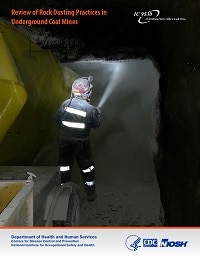Mining Publication: Review of Rock Dusting Practices in Underground Coal Mines
Original creation date: November 2016
Authors: SP Harteis, DW Alexander, ML Harris, M Sapko, ES Weiss
NIOSHTIC2 Number: 20048738
Pittsburgh, PA: U.S. Department of Health and Human Services, Public Health Service, Centers for Disease Control and Prevention, National Institute for Occupational Safety and Health, DHHS (NIOSH) Publication No. 2017-101 (IC 9530), 2016 Oct; :1-89
Proper rock dusting practices have proven to be an effective means of preventing coal dust explosions. Rock dust (generally pulverized limestone dust) serves as a heat sink material that prevents or suppresses a propagating coal dust explosion through the absorption of thermal energy from the heated gases and absorption of radiant energy, which reduces the preheating of unburned coal particles ahead of the flame front. Therefore to effectively suppress a coal dust explosion, sufficient quantities of dispersible rock dust must be entrained into the mine entry by the expanding explosion pressure wave to inert the coal dust, also entrained in the entry. The in-mine application of rock dust dates back to the early 1900s. Since that time, significant technological improvements to rock dust application methods have been implemented along with increasingly stringent regulatory requirements and inspections to ensure adequate quantities of rock dust are applied to the roof, ribs, and floor throughout the mine. Even with enhancements to the rock dusting application methods and equipment, coal mining operations still experience compliance issues associated with meeting the current total incombustible content (TIC) requirement of at least 80% for all mine dust samples.
The National Institute for Occupational Safety and Health (NIOSH) conducted general surveys of rock dusting practices at nine underground coal mining operations and met with Mine Safety and Health Administration (MSHA) mine inspectors and District personnel to gain a better understanding of the rock dusting practices and associated compliance issues during this survey period. These surveys included obtaining the following from each of the nine mines:
- Mine dust samples to assess the incombustible content (IC) for determining any rock dust deficient areas common to all nine mines,
- Information and issues related to rock dusting, and
- Rock dusting sampling practices.
This report discusses research that was conducted in the NIOSH laboratories, experimental mine, and in operating mines to evaluate the potential explosion hazard associated with excessive coal dust accumulating on elevated surfaces, the efficacy of wet rock dusting, and the need for mines to develop comprehensive rock dusting programs. Taken as a whole, this report provides proactive approaches to current rock dusting practices that will improve the application of rock dust in all underground areas of a coal mine.

NIOSHTIC2 Number: 20048738
Pittsburgh, PA: U.S. Department of Health and Human Services, Public Health Service, Centers for Disease Control and Prevention, National Institute for Occupational Safety and Health, DHHS (NIOSH) Publication No. 2017-101 (IC 9530), 2016 Oct; :1-89
- Coal Dust Explosibility
- Coal Dust Explosibility Meter Evaluation and Recommendations for Application
- Coal Dust Particle Size Survey of U.S. Mines
- Coal Dust Particle Size Survey of US Mines
- Determining Flame Travel Measurements from Experimental Coal Dust Explosions
- How Does Limestone Rock Dust Prevent Coal Dust Explosions in Coal Mines?
- Mitigating Coal Dust Explosions in Modern Underground Coal Mines
- Recommendations for a New Rock Dusting Standard to Prevent Coal Dust Explosions in Intake Airways
- Rock Dusting Considerations in Underground Coal Mines
- Technology News 515 - Float Coal Dust Explosion Hazards